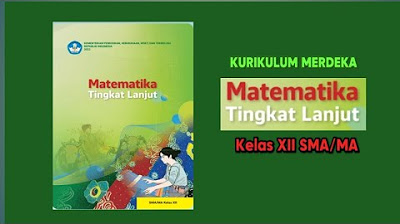SHS Pre-calculus Q1 Ep1: Introduction to Pre-calculus and Conic Sections
Summary
TLDRIn this engaging pre-calculus video, Teacher Zoi introduces high school STEM students to the fascinating world of conic sections, a set of topics that pave the way for calculus. The lesson covers the concepts of ellipses, circles, parabolas, hyperbolas, and their real-life applications, from the structure of a roundabout to the design of nuclear cooling towers. With interactive examples and a virtual tour, the video aims to demonstrate the beauty and relevance of mathematics in everyday life, encouraging students to appreciate the subject's practicality and wonder.
Takeaways
- 📚 The video introduces the first episode of a pre-calculus series for senior high school STEM students, emphasizing the beauty and wonder of mathematics.
- 🔍 Pre-calculus is a set of topics designed to prepare students for in-depth calculus studies, covering conic sections, systems of nonlinear equations, series, mathematical induction, binomial theorem, circular functions, trigonometric identities, inverse trigonometric functions, and the polar coordinate system.
- 📐 Conic sections are curves formed by the intersection of a plane with a double right circular cone, and include parabolas, ellipses, circles, and hyperbolas, with degenerate cases being points, lines, or intersecting lines.
- 🏰 The video uses the example of Koenig's room to illustrate how conic sections are found in everyday objects and architecture.
- 🎾 The trajectory of a ball in projectile motion, as seen in a sports game, is a parabola, showing the real-life application of conic sections.
- 🌐 The design of a nuclear cooling tower in Bataan, Philippines, utilizes the hyperbolic form for structural integrity and material efficiency.
- 🚀 Johannes Kepler's discovery that planets orbit the sun in elliptical paths with the sun at one of the foci is highlighted to demonstrate the relevance of conic sections in astronomy.
- 🌐 The 11th World Scout Jamboree Memorial Rotunda in Quezon City is a real-life example of a circle, a type of conic section, used in architecture and urban planning.
- 🛣 The concept of roundabouts or traffic circles, which are circular intersections, is explained in terms of traffic flow and road safety, showing the practical application of mathematical concepts.
- 🎓 The video concludes with a review and a math wrap-up, summarizing the key concepts of conic sections and their real-world applications.
- 📝 The video script includes interactive elements such as a quiz to reinforce learning and engagement with the material presented.
Q & A
What is the main focus of the 'Math Terrific' pre-calculus series?
-The 'Math Terrific' pre-calculus series focuses on exploring the beauty and wonders of mathematics, specifically covering concepts that prepare students for calculus, such as conic sections, systems of nonlinear equations, series, mathematical induction, binomial theorem, circular functions, trigonometric identities, inverse trigonometric functions, and the polar coordinate system.
What are conic sections and how are they formed?
-Conic sections are two-dimensional curves formed when a plane intersects the surface of a double right circular cone. Depending on the angle of intersection, they can be an ellipse, circle, parabola, or hyperbola.
What is the significance of the circle in the context of conic sections?
-A circle is a special type of ellipse formed when the plane intersecting the double right circular cone is perpendicular to the axis.
What is the term used for the straight line that rotates about a fixed point from a vertical line to form a double right circular cone?
-The straight line is called a 'generator'.
What is the conic section formed when the angle made by the plane to the vertical axis is exactly equal to the vertex angle?
-A parabola is formed under this condition.
What is the real-life application of the hyperbolic form as seen in nuclear cooling towers?
-The hyperbolic form is used in nuclear cooling towers because it is structurally sound and can be built with straight steel beams, which helps to withstand high winds and is material-efficient.
What did Johannes Kepler discover about the orbits of planets around the sun?
-Johannes Kepler discovered that each planet travels around the sun in an elliptical orbit, with the sun at one of the foci.
What is the term for the fixed point that joins the double right circular cone?
-The fixed point is called the 'vertex'.
What are the degenerate cases of conic sections?
-Degenerate cases of conic sections include a point, a line, or intersecting lines, which occur when a plane intersects a double right circular cone at its vertex.
How can one enhance their knowledge and skills in pre-calculus according to the script?
-One can enhance their knowledge and skills in pre-calculus by engaging in virtual activities, following the teacher's personal blog site on Facebook, and subscribing to the official YouTube channel for updates and more pre-calculus sessions.
What is the role of a roundabout in traffic flow and road safety?
-A roundabout benefits traffic flow by eliminating stop signals and encourages slower driving speeds, which can dramatically reduce the potential for t-bone and head-on collisions, thus reinforcing road safety.
Outlines

This section is available to paid users only. Please upgrade to access this part.
Upgrade NowMindmap

This section is available to paid users only. Please upgrade to access this part.
Upgrade NowKeywords

This section is available to paid users only. Please upgrade to access this part.
Upgrade NowHighlights

This section is available to paid users only. Please upgrade to access this part.
Upgrade NowTranscripts

This section is available to paid users only. Please upgrade to access this part.
Upgrade NowBrowse More Related Video

Intro to Conic Sections | Pre Calculus | STEM Math

Matematika tingkat lanjut kelas XII (12) SMA /MA Kurikulum merdeka @GUcilchaNEL1964

Pre Calculus 1st Quarter Topics || Grade 11 STEM Subject|| #stemstudents #stem #grade11math

Como eu estudaria Cálculo em apenas 30 dias

Matemática do COMEÇO ao FIM! Todos os livros que você precisará.

Prereq 13: Complex Numbers
5.0 / 5 (0 votes)